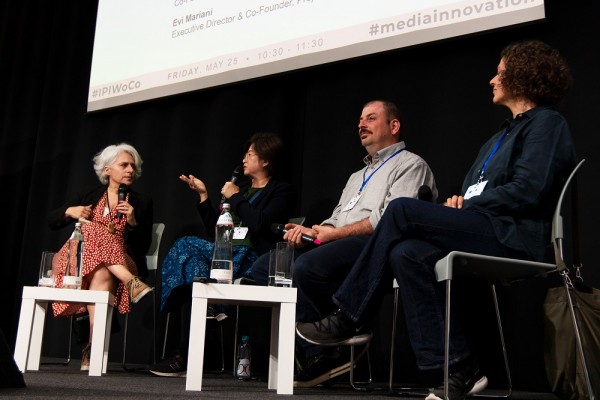Venezuela’s Trunk Road 10 becomes BR-174 when it crosses the border with Brazil, in the state of Roraima. That’s where Katia Brasil, originally from Fortaleza, took her first steps as a journalist, in the state capital, Boa Vista, distinguishing herself as a reporter with access to a wide range of sources.
When a murder plot involving parts of the local government was uncovered, Katia received death threats and left Roraima for Manaus further south. There, together with Elaize Farias, from Parintins down-river, she founded the Amazonia Real portal.
Their short documentary film “Agachados” (Ducked) opens with an aerial shot of Manaus showing a motor boat navigating the waters of the Rio Negro between over-water bungalows known as palafitas. In the next shot, it’s a bus that navigates between buildings. It’s a way of introducing the reality of seasonal flooding of the Río Negro which joins the Amazon at the town. In 2021, it reached its highest level in 119 years of monitoring.
The skilful succession of images anticipates the kind of storytelling. There is no omniscient narrator, just the voice of the people affected who inhabit the fringes of Manaus in the garrets of their shacks, with water up to their ankles, knees or waists, and have had to adapt their routine to these conditions. They sleep dry, but live wet and walk duck-like during the day.

Screenshot from the documentary ‘Agachados’. Source: youtube
Amazonia Real is a generalist digital outlet and news agency focusing on the traditional populations of the Amazon, especially those ignored by the mainstream press, with a network of journalists in all the states of the Brazilian Amazon. Their site also hosts the blog Jovens Cidadãos da Amazônia, with contributions by people from the indigenous communities.
Amazonia Real stands out from the rest because it is a space where people from the different communities in the Amazon can directly make their voices heard. It brings breadth and depth to its coverage with a network of journalists covering both the Brazilian Amazon and the basin in neighbouring countries.
Its main focus is on indigenous peoples and the environment. It ranges from investigative and data journalism to news, culture, politics and economics. Its special features include diverse topics like the poetry of Tiago Hakiy, the librarian of the village of Barreirinha, or the destruction by the federal police of 167 mining rafts on the Madeira River, a tributary of the Amazon.
This latest episode reveals the tense situation in the federal states of the Brazilian Amazon, with an incoming population largely inclined to Bolsonarism and extremely hostile to indigenous people and environmental policies. They come with open demands for deforestation, mining and industrial expansion.
Amazonia Real also forges alliances with Reporter Brasil in Ouro de Sangue Yanomami (Yanomami Blood Gold), with its exposure of how mining travels from local devastation and clandestine tracks, supported by the penetration of crime syndicates and corrupt politicians, and bringing along mercury contamination and diseases such as Covid and malaria, to end up in the jewellery stores of the world’s metropolises.
Amazonia Real has given disadvantaged communities of the Amazon a voice to speak to the global centre. It has won numerous awards, such as the 2018 King of Spain International Journalism Award as the most outstanding outlet in Ibero-America.
These local media and their national and international allies have opened a window to day-to-day life with gigantic global implications. Their work makes clear that local actors can increasingly become decisive when addressing global issues. The similarities between what is happening in the different countries of the Amazon should force us to pay more attention and understand that these are not separate problems, but one big problem that we are obliged to solve in order to survive.
Want more? Read parts one here and two here.
Andrés Schäfer is a Madrid-based freelance researcher and journalist. You can see more of his stories for IPI here.



